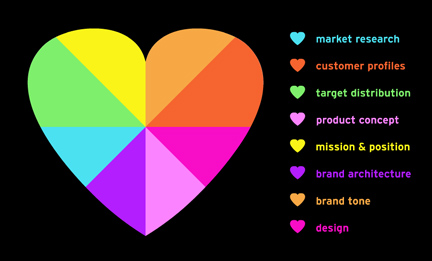
The Beauty of Strategy – A 360° Look at Building a Viable Brand
Statistically, 80 percent of start-up beauty brands do not survive their first two years of business.* There are many factors contributing to this failure rate. One of them is certainly due to money. Simply put, it costs a lot to start a beauty brand — from the cost of development and formulations, to the long development lead time and the manufacturing minimums required.
It is easy to understand why it is essential to develop a brand with specific targeted goals in mind. When one considers the large costs that lay ahead in brand development alone, the cost of creating a targeted strategy is relatively minimal. Yet, so often, this crucial planning step is forgotten!
We understand. Defining who you are and where you are going is hard work. It is especially difficult to find the time to do this in the midst of all the other work you already have. Yet, time and time again, those who define their niche and build their brand are rewarded.
This is what defines the 20% of successes.
A brand without a clear strategy is an empty shell. If you do not clearly define your brand, someone else will. A well-crafted brand strategy is the lifeblood that will feed the essence of your brand. This will ultimately become the heart of everything your business touches. Any credible designer will not be able to craft your story into a compelling visual or message unless you have this essence. Without a brand strategy, he will need to fill your empty shell with something. What if that something isn’t on track?
Here are some components MSLK uses to create an effective brand strategy:
Market Research It is important to know what is trending in your competitive space. What are hot topics, ingredients, and areas of interest for consumers? If you already have a brand presence, how do customers perceive your existing brand?
Customer Profiles It is important to be honest about the demographic profile of the customer who will appreciate and benefit most from your product. All too often, brands define their target customers as “women ages 18-55″ or as “young, modern women.” This is not an adequate customer profile! The more specific the profile, the better chance you’ll reach them.
Target Distribution With clearly defined Customer Profiles, information such as your customer’s spending preference and shopping patterns will emerge. Keep this in mind as you establish a distribution plan. Where do these customers shop? It is important to consider new channels of distribution and bring your target distributors into the brand development conversation.
Product Concept One of the ways to cut through the clutter and stand out to consumers and distributors alike is to have a clearly defined Product Concept. Whether this is a key ingredient story, a series of key ingredients, new product form, delivery system, or clinical trials — these compelling stories can help you differentiate your product’s point-of-difference in the market.
Mission and Position Your Mission Statement will help solidify and clarify your distinct place and purpose in the market for every member of your team. Your Positioning (in both written and chart form) will help show at a glance where you sit in the marketplace in relation to your competitors. Use this information as a guide for every decision your company makes.
Brand Architecture Brand Architecture establishes how your product line(s) will be organized. Will you have multiple levels of product lines such as “premium” and “mass” to target different distributors? Will your products be organized by ingredient story, key consumer benefits, or by daily regimen? These decisions affect your business structure, marketing approach, and the consumer communication on the packaging itself.
Brand Tone This exploration determines the overall feeling customers will receive when they experience your brand, whether it be a physical experience or a virtual one in print or online. Will your brand be seen as a “clinical professional product that speaks with a tone of authority?” Or will you be seen as a “friendly and approachable brand as gentle as nature intended?” Your Brand Tone should be naturally congruent with the brand’s DNA.
Design This is the moment that we can visually bring all of these principles to life. A smart design strategy turns the highly subjective process of evaluating art into an objective process. With the other parts defined, we can evaluate the fonts, colors, imagery, copy, and overall mood of the designs by asking questions such as: “Does this convey the brand’s Mission and Position?”
These eight components of Brand Strategy add up to help a brand cut through the retail clutter, connect with consumers, and become an enduring, sustainable brand that defies the odds.
*Based on research from the U.S. Department of Commerce, Census Bureau, Business Dynamics Statistics; U.S. Department of Labor, Bureau of Labor Statistics, BED


